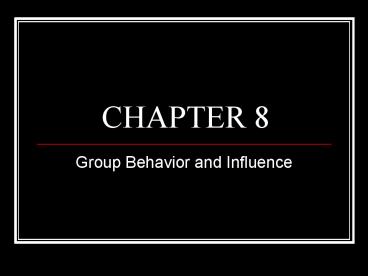Group Behavior and Influence - PowerPoint PPT Presentation
1 / 17
Title:
Group Behavior and Influence
Description:
Counteracting social loafing (increased accountability, task perceived as ... Synectics. Electronic brainstorming. Use of small groups or pairs ... – PowerPoint PPT presentation
Number of Views:200
Avg rating:3.0/5.0
Title: Group Behavior and Influence
1
CHAPTER 8
- Group Behavior and Influence
2
Motivation in groups social loafing
- Social loafing
- When do we loaf the most? (task interest, value,
choice knowledge of other group members size
and gender composition of group cultural context - Why do we loaf? (identifiability contributions
not rewarded, needed, and/or too costly) - Karau and Williams collective effort model
- Counteracting social loafing (increased
accountability, task perceived as unique or
challenging, group pride, external rewards,
social compensation)
3
Social loafing some ways to overcome it
- Factors that increase loafing
- Lack of identifiability
- No individual evaluation
- No individual or group
- standards of evaluation
- Task is easy, boring, or the
- same as others
- Individual contributions are
- not necessary
- No individual or group incentives
- Large group
- Unfamiliar group
- Factors that reduce loafing
- Individual identifiability
- Individual or group evaluation
- Individual or group standards
- of evaluation
- Task is difficult, interesting, or
- different from others
- Individual contributions are
- essential
- Individual or group incentives
- Small group
- Familiar group
4
Motivation in groups social facilitation
- Social facilitation
- Arousal model if the dominant responses are
correct, performance is enhanced if the dominant
responses are incorrect, performance is impaired - Evaluation model evaluation can create
evaluation apprehension and also serve as source
of distraction
5
Brainstorming creativity in groups
- Four basic rules of brainstorming (feel free to
express all ideas generate as many as possible
build on other peoples ideas and dont
criticize them) - Factors that inhibit brainstorming
- Evaluative concern
- Free riding
- Blocking
- Social comparison
- Illusion of group productivity
6
(No Transcript)
7
Brainstorming creativity in groups
- Improving group brainstorming
- Prior practice with brainstorming
- Nominal group technique
- Brainwriting
- Synectics (spectrum policy, metaphors, analogies,
etc.) - Electronic brainstorming stages of idea
generation, organization, ranking, and ideas for
implementation - Use of small groups or pairs
- Use of certain personality types (low social
anxiety)
8
Better brainstorming some techniques
- First practice with group brainstorming
- Alternate individual and group brainstorming
- Use spectrum policy ? look at all sides of the
issue - Use small groups or pairs
- Create diverse groups with a variety of
perspectives, talents, and knowledge bases - Give the groups some goals for which to aim
- Use group brainstorming with less socially
anxious individuals - Use electronic brainstorming or brainwriting
9
Group decision making
- Major pitfalls
- Disorganization (nonoptimal approach)
- Strength in numbers effect
- Group polarization
- Affected by normative and informational influence
- Momentum toward the already favored position
- Extremist versus mixed groups
- Self-selection bias favoring homogeneous groups
10
Group decision making
- Information biases in groups
- Sampling bias
- Instruct members to mention only items that have
not already been shared - Have groups rank the various alternatives, rather
than simply choosing the apparently best one - Inform the group about the unique areas of
expertise of particular group members - Directive versus participative group leaders
- Repeating shared knowledge more than unshared
knowledge during the group discussion (the
common knowledge effect)
11
Counteracting the common-knowledge effect and the
sampling bias
- Force group members to mention only unique
information - Rank alternatives
- Assign expertise
- Include confident experts
- Include directive leaders? (pros and cons)
12
(No Transcript)
13
Group decision making
- Groupthink defective decision-making in groups
- Concurrence seeking group cohesiveness,
isolation, lack of checks, pre-determined
outcome, pressure for decision - Symptoms of groupthink direct pressure, pressure
to uniformity, self-censorship, mindguards,
illusion of unanimity, misperception,
rationalization - Defective decision making poor information
search, incomplete survey of alternatives and
objectives, information processed in a biased
fashion, failure to re-appraise, no contingency
plan(s)
14
The phenomenon of groupthink
15
Groupthink some major symptoms
- Symptoms of Groupthink
- Illusion of invulnerability
- Collective rationalization
- Belief in the morality of the group
- Stereotyping of outgroups
- Direct pressure on dissenters
- Self-censorship
- Illusion of unanimity
- Mindguards
- Symptoms of defective
- decision-making
- Incomplete survey of alternatives
- Incomplete survey of objectives
- Failure to examine the risks of the favored
alternative - Poor information search
- Selective bias in processing available
information - Failure to reassess alternatives
- Failure to work out contingency plans
16
Group decision making
- Groupthink defective decision-making in groups
- Avoiding groupthink rules for good
decision-making (Table 8.5) - Teamwork and groupthink problems of
self-management (Table 8.6) - Develop effective decision-making norms and
practices - Increase interaction with new or outside members
- Train self-leadership skills
- Select team members with a desire for independence
17
Rules for good decision-making
- Set a good decision-making goal
- Organize the procedures for decision-making
- Do a systematic search for the information held
by group members - Make group members accountable for sharing the
information needed to make a good decision - Have a diversity of views and expertise
represented in the group - Use second-chance meetings to re-evaluate the
decision































